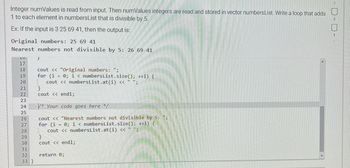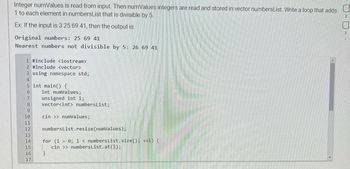
Computer Networking: A Top-Down Approach (7th Edition)
7th Edition
ISBN: 9780133594140
Author: James Kurose, Keith Ross
Publisher: PEARSON
expand_more
expand_more
format_list_bulleted
Question
thumb_up100%

Transcribed Image Text:Integer numValues is read from input. Then numValues integers are read and stored in vector numbers List. Write a loop that adds
1 to each element in numbersList that is divisible by 5.
Ex: If the input is 3 25 69 41, then the output is:
Original numbers: 25 69 41
Nearest numbers not divisible by 5: 26 69 41
LU
17
18
19
20
21
22
23
24
25
26
789RLEM
27
28
29
30
31
32
33 }
Ĵ
cout << "Original numbers: ";
for (i = 0; i < numbers List.size(); ++i) {
cout << numbers List.at (i) << " ";
}
cout << endl;
* Your code goes here */
cout << "Nearest numbers not divisible by 5: ":
for (i = 0; i < numbers List.size(); ++i) {
cout << numbers List.at (i) << " ";
}
cout << endl;
return 0;

Transcribed Image Text:Integer numValues is read from input. Then numValues integers are read and stored in vector numbersList. Write a loop that adds
1 to each element in numbersList that is divisible by 5.
Ex: If the input is 3 25 69 41, then the output is:
Original numbers: 25 69 41
Nearest numbers not divisible by 5: 26 69 41
1 #include <iostream>
2 #include <vector>
3 using namespace std;
4
5
6
7
8
9
10
11
12
13
14
15
16
17
int main() {
int numValues;
unsigned int i;
vector<int> numbers List;
cin >> numValues;
numbersList.resize(numValues);
for (i = 0; i < numbers List.size(); ++i) {
cin >> numbers List.at(i);
}
2
Expert Solution
This question has been solved!
Explore an expertly crafted, step-by-step solution for a thorough understanding of key concepts.
This is a popular solution
Trending nowThis is a popular solution!
Step by stepSolved in 4 steps with 2 images

Knowledge Booster
Similar questions
- %matplotlib inlineimport numpy as npfrom matplotlib import pyplot as pltimport math xs = np.array([0. , 0.01010101, 0.02020202, 0.03030303, 0.04040404, 0.05050505, 0.06060606, 0.07070707, 0.08080808, 0.09090909, 0.1010101 , 0.11111111, 0.12121212, 0.13131313, 0.14141414, 0.15151515, 0.16161616, 0.17171717, 0.18181818, 0.19191919, 0.2020202 , 0.21212121, 0.22222222, 0.23232323, 0.24242424, 0.25252525, 0.26262626, 0.27272727, 0.28282828, 0.29292929, 0.3030303 , 0.31313131, 0.32323232, 0.33333333, 0.34343434, 0.35353535, 0.36363636, 0.37373737, 0.38383838, 0.39393939, 0.4040404 , 0.41414141, 0.42424242, 0.43434343, 0.44444444, 0.45454545, 0.46464646, 0.47474747, 0.48484848, 0.49494949, 0.50505051, 0.51515152, 0.52525253, 0.53535354, 0.54545455, 0.55555556, 0.56565657, 0.57575758, 0.58585859, 0.5959596 , 0.60606061, 0.61616162, 0.62626263, 0.63636364, 0.64646465, 0.65656566, 0.66666667,…arrow_forwardCreat a void fuction void myUpdate(string dictionary[], int wordCount, string oldWord, string newWord); Where it will replace the oldWord with the newWord, if the search is successfularrow_forwardBinary search can only be performed on a/an ………… Sorted array/list Random array/list Any array/list Disordered array/listarrow_forward
- JS Write a function named find_value that takes a list/array of whole numbers as a parameter. Your functio will need to find if the parameter contains the value 3 as an entry. Return true if the input has an entry equivalent to 3 and false if it does not.arrow_forwardWrite a for loop to print all NUM_VALS elements of vector courseGrades, following each with a space (including the last). Print forwards, then backwards. End with newline. Ex: If courseGrades = {7, 9, 11, 10}, print:7 9 11 10 10 11 9 7 Hint: Use two for loops. Second loop starts with i = courseGrades.size() - 1 (Notes)C++ without using std:: Note: These activities may test code with different test values. This activity will perform two tests, both with a 4-element vector (vector<int> courseGrades(4)). See "How to Use zyBooks".Also note: If the submitted code has errors, the test may generate strange results. Or the test may crash and report "Program end never reached", in which case the system doesn't print the test case that caused the reported message. #include <iostream>#include <vector>using namespace std; int main() { const int NUM_VALS = 4; vector<int> courseGrades(NUM_VALS); int i; for (i = 0; i < courseGrades.size(); ++i) { cin >>…arrow_forwardWrite a loop that counts how many elements in an array are equal to zero. arrays.cpp 1 #include // sizet 2 int countZeros (const int values[], size_t size) { int count = 0; 3 4 for (int i; i using namespace std; 3 2 4 int countZeros(const int values[], size_t size); 5 int main() { int a[] = {1, 2, 0, 3}; cout <« countZeros (a, 4) <« endl; cout « "Expected: 1" « endl; 6 7 8 9 10 11 int b[] = {0, 2, 0, 3}; cout <« countZeros (b, 4) <« endl; cout « "Expected: 2" « endl; 12 13 14 15 int cl] -{1, 0, θ, 0, 0 ; cout <« countZeros (c, 5) <« endl; cout « "Expected: 4" « endl; 16 17 18 19 } CodeCheck Reset Testers Running Tester.cpp pass fail fail 1 Expected: 1 Expected: 2 Expected: 4 Score 1/3arrow_forward
- For any element in keysList with a value greater than 50, print the corresponding value in itemsList, followed by a comma (no spaces). Ex: If the input is: 32 105 101 35 10 20 30 40 the output is: 20,30, 1 #include 2 3 int main(void) { const int SIZE_LIST = 4; int keysList[SIZE_LIST]; int itemsList[SIZE_LIST]; int i; 4 6 7 8 scanf("%d", &keysList[0]); scanf ("%d", &keysList[1]); scanf("%d", &keysList[2]); scanf("%d", &keysList[3]); 10 11 12 13 scanf ("%d", &itemsList[0]); scanf ("%d", &itemsList[1]); scanf("%d", &itemsList[2]); scanf ("%d", &itemsList[3]); 14 15 16 17 18 19 /* Your code goes here */ 20 21 printf("\n"); 22 23 return 0; 24 }arrow_forwardThere is no difference between an array and an arraylist True Falsearrow_forwardRecamán's sequence def recaman(n): Compute and return the first n terms of the Recamán's sequence, starting from the term a1 = 1.Note how the definition for the current next element depends on whether a particular number is already part of the previously generated part of the sequence. To let your function execute in a speedy fashion even when generating a sequence that contains millions of elements, you should use a set to keep track of which values are already part of the previously generated sequence. This way you can generate each element in constant time, instead of having to iterate through the entire previously generated list. The better technique that saves time by using more memory can create this list arbitrarily far in linear time, and should therefore be fast even for millions of elements, at least until it runs out of memory. n Expected result 10 [1, 3, 6, 2, 7, 13, 20, 12, 21, 11] 1000000 (a list of million elements whose last five elements are [2057162,1057165,…arrow_forward
- Integer numValues is read from input. Then numValues integers are read and stored in vector weeklyRentList. Write a loop that outputs each element in weeklyRentList that is less than 100, and assigns the element with twice the element's current value. End each output with " is corrected to twice the current value' followed by a newline. Ex: If the input is 3 31 143 105, then the output is: Raw weekly rent: 31 143 105 31 is corrected to twice the current value Adjusted weekly rent: 62 143 105 1 #include 2 #include 3 using namespace std; 4 5 int main() { 6 int numValues; 7 unsigned int i; 0 vector weeklyRentList; cin >> numValues; 10 11 weeklyRentList.resize(numValues); for (i = 0; i > CS Scanned 12 13 14 17 18 cout << "Raw weekly rent: " ローローarrow_forwardIntegers are read from input and stored into a vector until 0 is read. If the vector's last element is odd, output the odd elements in the vector. Otherwise, output the even elements in the vector. End each number with a newline. Ex: If the input is -9 12 -6 1 0, the vector's last element is 1. Thus, the output is: -9 1 Note: (x % 2 != 0) returns true if x is odd. int value; int i; bool isodd; 7 8 9 10 11 12 13 14 15 16 17 18 19 20 21 22 23 } cin >> value; while (value != 0) { } for (i = 0; i > value; Check return 0; 1 Next level 2 X 1: Compare output 3 4 For input -9 12 -6 1 0, the vector elements are -9, 12, -6, and 1. The last element, 1, is odd. The odd elements in the vector, -9 and 1, are output, each on a new line. Not all tests passed. 2 V 3arrow_forwardIntegers are read from input and stored into a vector until 0 is read. If the vector's last element is odd, output the odd elements in the vector. Otherwise, output the even elements in the vector. End each number with a newline. Ex: If the input is -9 12 -6 1 0, the vector's last element is 1. Thus, the output is: -9 1 Note: (x % 2!= 0) returns true if x is odd. 4 5 int main() { 6 7 8 9 10 11 12 13 14 15 16 17 18 19 20} vector vect1; int value; int i; bool isodd; cin >> value; while (value != 0) { vect1.push_back(value); cin >> value; } V* Your code goes here */ return 0; 2 3arrow_forward
arrow_back_ios
SEE MORE QUESTIONS
arrow_forward_ios
Recommended textbooks for you
 Computer Networking: A Top-Down Approach (7th Edi...Computer EngineeringISBN:9780133594140Author:James Kurose, Keith RossPublisher:PEARSON
Computer Networking: A Top-Down Approach (7th Edi...Computer EngineeringISBN:9780133594140Author:James Kurose, Keith RossPublisher:PEARSON Computer Organization and Design MIPS Edition, Fi...Computer EngineeringISBN:9780124077263Author:David A. Patterson, John L. HennessyPublisher:Elsevier Science
Computer Organization and Design MIPS Edition, Fi...Computer EngineeringISBN:9780124077263Author:David A. Patterson, John L. HennessyPublisher:Elsevier Science Network+ Guide to Networks (MindTap Course List)Computer EngineeringISBN:9781337569330Author:Jill West, Tamara Dean, Jean AndrewsPublisher:Cengage Learning
Network+ Guide to Networks (MindTap Course List)Computer EngineeringISBN:9781337569330Author:Jill West, Tamara Dean, Jean AndrewsPublisher:Cengage Learning Concepts of Database ManagementComputer EngineeringISBN:9781337093422Author:Joy L. Starks, Philip J. Pratt, Mary Z. LastPublisher:Cengage Learning
Concepts of Database ManagementComputer EngineeringISBN:9781337093422Author:Joy L. Starks, Philip J. Pratt, Mary Z. LastPublisher:Cengage Learning Prelude to ProgrammingComputer EngineeringISBN:9780133750423Author:VENIT, StewartPublisher:Pearson Education
Prelude to ProgrammingComputer EngineeringISBN:9780133750423Author:VENIT, StewartPublisher:Pearson Education Sc Business Data Communications and Networking, T...Computer EngineeringISBN:9781119368830Author:FITZGERALDPublisher:WILEY
Sc Business Data Communications and Networking, T...Computer EngineeringISBN:9781119368830Author:FITZGERALDPublisher:WILEY

Computer Networking: A Top-Down Approach (7th Edi...
Computer Engineering
ISBN:9780133594140
Author:James Kurose, Keith Ross
Publisher:PEARSON

Computer Organization and Design MIPS Edition, Fi...
Computer Engineering
ISBN:9780124077263
Author:David A. Patterson, John L. Hennessy
Publisher:Elsevier Science

Network+ Guide to Networks (MindTap Course List)
Computer Engineering
ISBN:9781337569330
Author:Jill West, Tamara Dean, Jean Andrews
Publisher:Cengage Learning

Concepts of Database Management
Computer Engineering
ISBN:9781337093422
Author:Joy L. Starks, Philip J. Pratt, Mary Z. Last
Publisher:Cengage Learning

Prelude to Programming
Computer Engineering
ISBN:9780133750423
Author:VENIT, Stewart
Publisher:Pearson Education

Sc Business Data Communications and Networking, T...
Computer Engineering
ISBN:9781119368830
Author:FITZGERALD
Publisher:WILEY